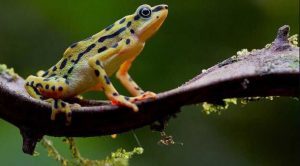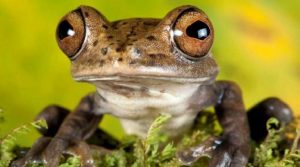A study published in the journal Nature Climate Change warns that up to 36% of terrestrial and arboreal amphibian habitats worldwide could be threatened by the combination of two key factors: reduced water availability and increased temperatures.
Brazil hosts the greatest global diversity of these animals, especially in the Amazon rainforest, a highly vulnerable ecosystem. Many of the most endangered species are found there, given that global warming and the intensification of droughts could drastically alter their environment.
An international team of scientists conducted the most comprehensive study to date on how the combination of more frequent droughts and global warming will affect anuran amphibians (frogs and toads). Their findings have been published in Nature Climate Change.
Rafael Bovo, a researcher at the University of California, Riverside, and co-author of the study, explains: “The Amazon and the Atlantic Forest are the ecosystems with the greatest diversity of amphibians and, at the same time, the most prone to an increase in the frequency, intensity, and duration of droughts. This will significantly affect the physiology and behavior of many species, some of which are endemic to these regions”.
The key data of the study were collected by Bovo during his doctoral and postdoctoral studies in Brazil, at the Institute of Biosciences of the Paulista State University and the University of São Paulo, respectively. This work is part of the project “The impacts of climate and environmental changes on fauna: an integrative approach”, coordinated by Carlos Navas and funded by FAPESP.

Alarming Forecasts: A More Arid Future
Projections indicate that between 6.6% and 33.6% of anuran habitats will experience increased aridity between 2080 and 2100, depending on the level of greenhouse gas emissions. In a moderate emissions scenario, with a temperature increase of 2°C, 15.4% of these territories will face more severe droughts. However, if global warming reaches 4°C, over a third of these habitats (36%) will be exposed to potentially devastating droughts.
Since amphibians have thin and highly permeable skin, they are extremely sensitive to water loss. In an extreme warming scenario, species in the Amazon, Central America, Chile, the northern United States, and the European Mediterranean will face an increase of over four months per year in the frequency of droughts. Even with a 2°C warming, the duration of droughts will increase by one to four months in much of the Americas, Europe, southern and central Africa, and southern Australia.
The Double Impact of Heat and Drought
Researchers found that in some arid regions, the rate of water loss in amphibians could double, drastically reducing their activity time. To avoid dehydration and extreme heat, these animals will spend more time in their shelters, which will limit their feeding and reproduction, putting the viability of their populations at risk.
Biophysical simulations revealed that in the Amazon and the Atlantic Forest, amphibian activity will decrease under all climate scenarios. While global warming alone would reduce their activity time by 3.4%, and drought by 21.7%, the combination of both factors would result in a 26% decrease.

Migrate, Adapt, or Disappear?
Researchers are evaluating whether some amphibian species have enough plasticity to adjust to drier environments in the short term or if they could adapt evolutionarily over thousands of years. This information will improve predictive models on local and regional extinctions and will serve as a reference for other species vulnerable to climate change.
“Amphibian species only have three options: migrate, adapt, or go extinct. Our goal is to determine which ones have the capacity to adjust their physiology and behavior in response to these extreme changes and predict what will remain of biodiversity by the end of the century,” concludes Bovo.
How Does Climate Change Affect Amazonian Amphibians?
Climate change affects amphibians in various ways, such as habitat loss, dehydration, and reproduction in unstable conditions. Regarding dehydration, these animals can be affected by precipitation scarcity, which can lead to this situation.
Additionally, this climatic phenomenon causes amphibians to reproduce in unstable conditions, such as before the breeding season, becoming more vulnerable to floods and frosts.
Have you checked out our YouTube channel? Subscribe now!

